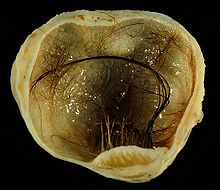Clinical cases/Case 2
<< Back to: Topic:Clinical cases

Case presentation
[edit | edit source]A primigravida visits the antenatal clinic at 39 weeks gestation to discuss her mode of delivery. She is 31 years old, had conceived soon after stopping combined oral contraceptive pills, had a routine ultrasound scan in the first trimester with no findings, and has reassuring medical, surgical and family histories.
Her pregnancy has been uneventful, with one minor exception. Between 34 and 39 weeks, her midwife repeatedly found the baby to have an unstable transverse lie, with the head palpable in various locations of the abdomen. Ultrasound scans by an obstetric ultrasonographer had not revealed a cause.
|
- Question: In most pregnancies, how does fundal height at 39 weeks compare to earlier weeks?
No change or decreased
Fundal height normally increases throughout the pregnancy, slowing to no change near term. When the baby drops into the pelvis in preparation for labor, the fundal height may decrease markedly. The baby can drop weeks before onset of labor, or during labor.
On abdominal examination, the baby's head can be moved easily, and the option of external cephalic version with artificial rupture of membranes is discussed with the woman. To see whether this woman already has a ripe cervix, a vaginal examination is performed.
|
- Question: What elements are part of this score?
The Bishop score contains 5 parts
- Cervical dilatation in centimeters
- Cervical effacement
- Cervical consistency (firm, intermediate, soft)
- Cervical position (posterior, intermediate, anterior)
- Fetal station relative to the ischial spine
On vaginal examination, the patient is found to have a large, soft pelvic mass. A targeted transabdominal ultrasound scan reveals a heterogenous transparent intrapelvic mass of 9 x 10 centimeters, posteriolateral to the right of the cervix, with an inlying cystic structure and no associated ascites. Doppler flow analysis shows no feeding vessels.
- Question: What is the appropriate mode of delivery for this woman?
Caesarean section with concomitant visualisation and possibly removal of the tumour.
Because of the relatively large pelvic mass causing a transverse lie, this woman is not an appropriate candidate for vaginal delivery. This was explained to the patient, and she was told the most likely diagnosis was a fibroid, or possibly a cyst. During surgery, this woman was found to have a multilocular ovarian cyst of the right ovary. Because it was not possible to separate the cyst from the ovary, both were removed. On pathological examination, the patient was found to have a teratoma (a cystic teratoma is also known as a dermoid cyst).
Case discussion
[edit | edit source]Review questions
- What are the possible differential diagnoses of ovarian cysts?
- What is the appropriate management of ovarian cysts in pregnancy?
Ovarian cysts during pregnancy

The differential diagnosis of ovarian cysts includes:
- Dermoid cyst
- cystadenoma
- corpus luteum cyst
- follicle cyste
- ovarian fibroma
- endometrioma
- haemorrhagic cyst
- cystadenocarcinoma
- ovarian metastasis (e.g. Krukenberg tumour)
The possibility of a malignant ovarian tumour always has to be contemplated when one is confronted with ovarian cysts. Small unilocular cysts are very unlikely to be malignant, but larger size and multilocularity increase this risk. In a prospective study, ovarian cysts larger than 6 cm in diameter in the second and third trimester of pregnancy were found in 0,2% of patients. Teratomas and functional cysts represent 50% and 20% of these, respectively, while the risk of ovarian cancer in these cases is estimated to be very small (around 2%). Ovarian cancer in general is found in 1 of 15-32000 pregnancies. Tumour-related proteins like CA-125 and beta-hCG are not useful in the diagnosis of ovarian tumours during pregnancy.
Since most cases are not dangerous for the mother or fetus, and since complications are rare in the second or third trimester, most ovarian cysts can be left alone during pregnancy. Diagnostic or therapeutic cyst aspiration is not advised during pregnancy. Caesarean section is advised only if the cyst prevents vaginal delivery, in which case the cyst can be removed simultaneously. If a suspicious mass warrants an intervention before delivery, exploratory laparotomy can be performed. Most benign and borderline ovarian tumours can be managed with conservative surgery.
References
[edit | edit source]- Ovarian cysts. eMedicine, C William Helm.
- Goffinet F (2001). "Ovarian cysts and pregnancy". J Gynecol Obstet Biol Reprod (Paris) 30 (1 Suppl): S100–8. PMID 11917371. http://www.masson.fr/masson/95358.
- Hill LM, Connors-Beatty DJ, Nowak A, Tush B (1998). "The role of ultrasonography in the detection and management of adnexal masses during the second and third trimesters of pregnancy". Am. J. Obstet. Gynecol. 179 (3 Pt 1): 703–7. PMID 9757975.
- Zanetta G, Mariani E, Lissoni A, et al (2003). "A prospective study of the role of ultrasound in the management of adnexal masses in pregnancy". BJOG 110 (6): 578–83. PMID 12798475.
- Leiserowitz GS (2006). "Managing ovarian masses during pregnancy". Obstet Gynecol Surv 61 (7): 463–70. doi:10.1097/01.ogx.0000224614.51356.b7. PMID 16787549. http://meta.wkhealth.com/pt/pt-core/template-journal/lwwgateway/media/landingpage.htm?doi=10.1097/01.ogx.0000224614.51356.b7.
Suggested activities
[edit | edit source]Now that you're done, why don't you:
- Suggest improvements to this learning activity, or edit it yourself.
- Read and improve Ovarian cyst on Wikipedia.
